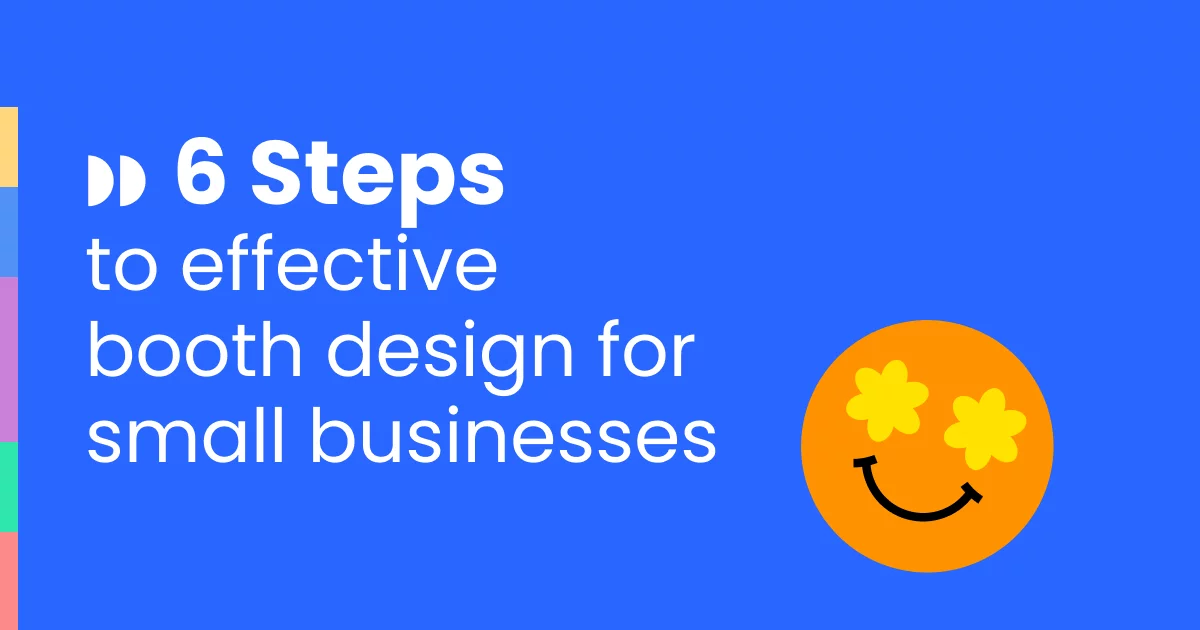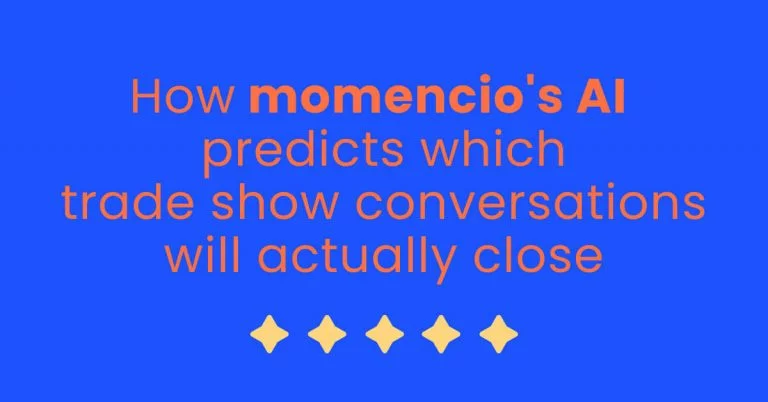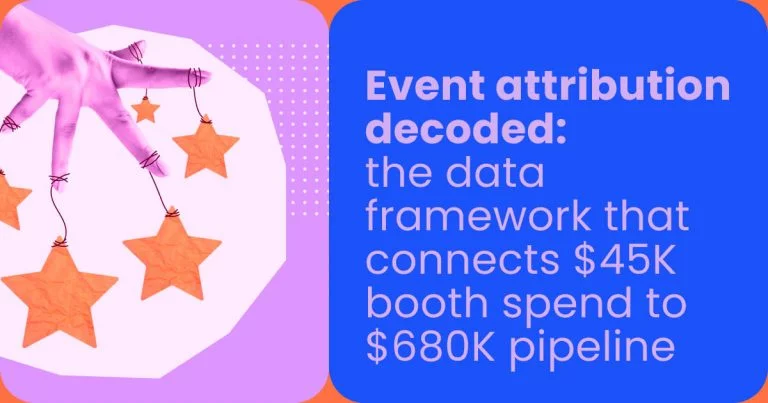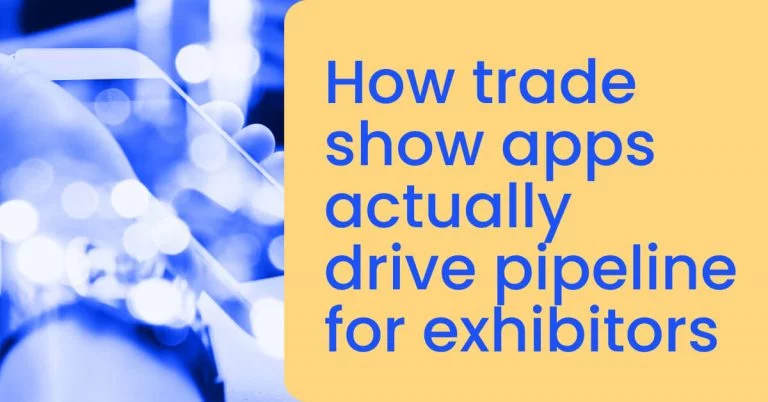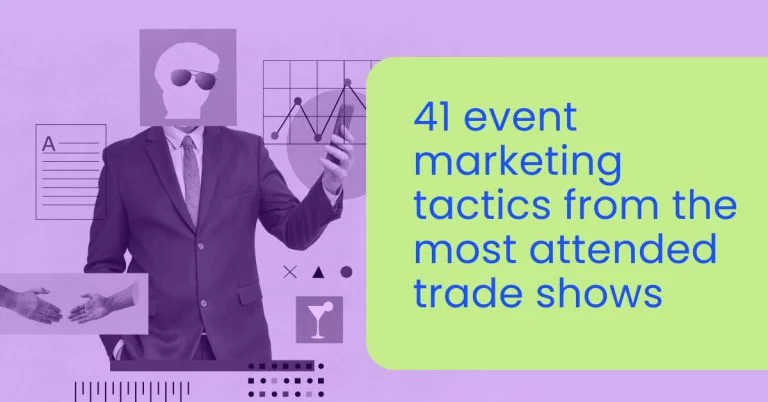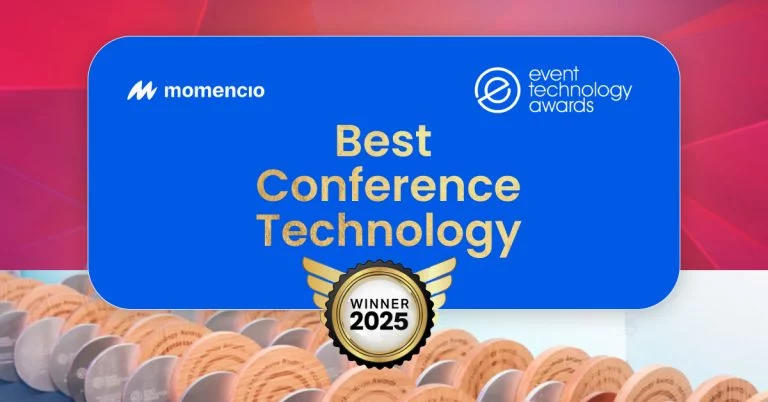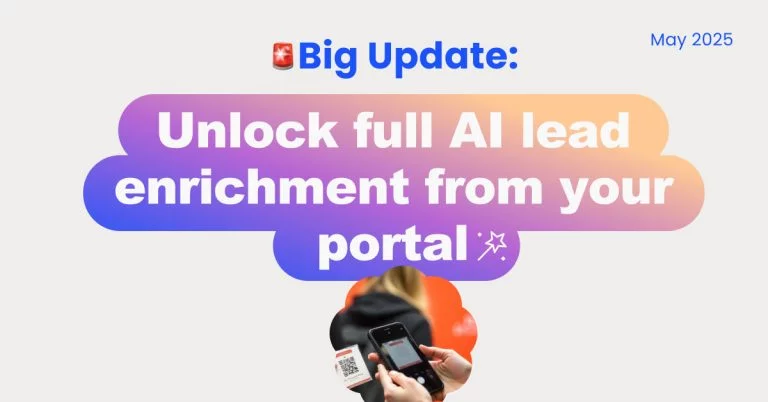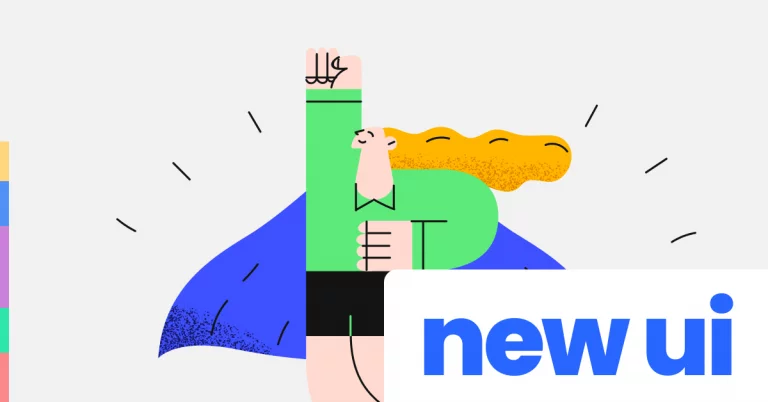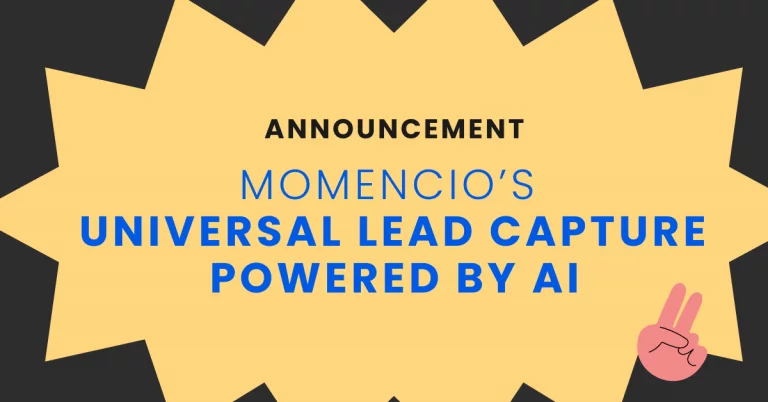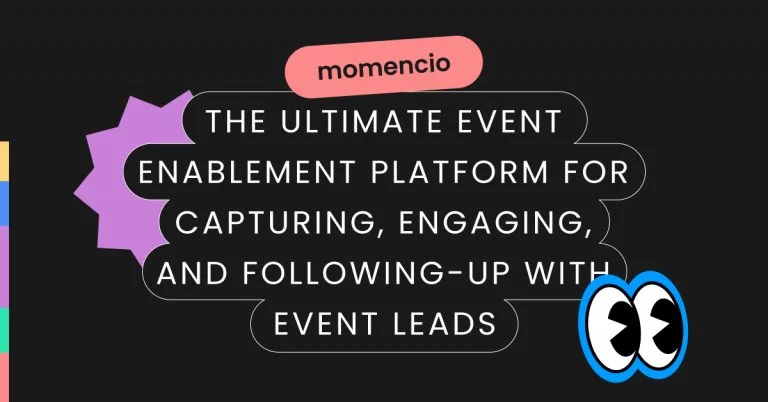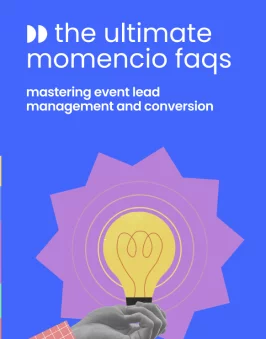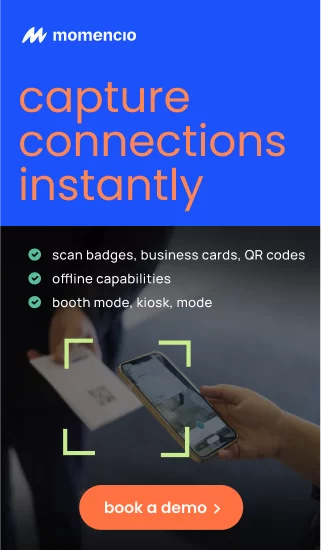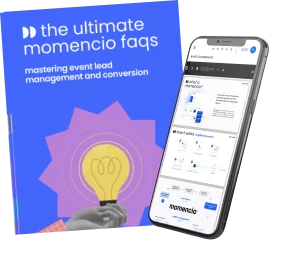If you’re a small business owner, exhibiting at a trade show can feel overwhelming. The stakes are high—you’re competing with big brands, and every visitor that passes by without stopping feels like a missed opportunity. But here’s the good news: You don’t need a massive budget to design a booth that grabs attention, pulls in visitors, and drives real results. You just need a strategy.
74% of trade show attendees say that engaging booth design impacts their decision to interact with exhibitors. That means, with the right booth setup, you can level the playing field with bigger competitors and stand out, even on a smaller budget.
In this step-by-step playbook, we will walk you through exactly how to design a high-impact booth that engages attendees, maximizes your space, and drives meaningful leads. Whether your goal is to generate sales, build brand awareness, or collect as many leads as possible, this guide will show you how to:
- Design a small booth layout that maximizes every square inch.
- Incorporate interactive elements that make people stop, engage, and remember you.
- Create budget-friendly, visually compelling booths that reflect your brand.
- Follow up after the event to convert leads into loyal customers.
So, let’s dive in—this isn’t just about booth design; it’s about setting up your small business for success at trade shows. Follow this guide, and you’ll have attendees talking about your brand long after the event is over.
Step #1 Set clear goals and understand your audience
Before you even think about the booth design, you need to get clear on why you’re exhibiting in the first place. Booth design only works when it’s aligned with your overall event goals. Without clear objectives, even the most creative booth won’t bring in the results you want.
Ask yourself these questions:
- Do you want to generate leads?
- Are you focused on building brand awareness?
- Or, are you there to drive on-the-spot sales?
Your goal will influence everything—from the booth’s layout to the interactive elements you include. For example:
- Lead generation? You’ll want to design a booth that encourages people to drop off business cards or scan badges.
- Brand awareness? Focus on creating a visually striking booth that tells your brand’s story.
- Sales? Build a space where your products can be easily demonstrated, and staff can focus on closing deals.
Pro Tip: Keep your primary goal visible. Whether that’s a digital screen showcasing your message or a bold headline like “Talk to us for a free consultation” at the front of the booth, it’s essential your visitors know exactly what you offer within seconds of seeing your booth.
Understand your audience once you’re clear on your goals, it’s time to focus on who will be walking through that trade show. Are they decision-makers, influencers, or end-users? What are their pain points, and how can your booth and messaging solve them?
Audience segmentation:
- Decision-makers care about ROI. They want to know how your solution impacts the bottom line.
- Influencers want to see innovative and exciting ideas they can advocate for in their companies.
- End-users are looking for practical demonstrations of how your product or service will make their life easier.
Use this information to tailor both your booth’s design and staff’s pitch to appeal directly to those visitors.
Action step: Write down the top three pain points your target audience has. Every design decision you make should address at least one of those pain points.
Step #2 Layout and maximize small spaces effectively
Here’s where you start putting your plan into action. When you’re working with a smaller booth, every inch matters. You need to make sure the space is optimized for flow and visitor engagement. Small doesn’t mean less effective—it means smarter.
Booth flow matters:
The key to an effective layout is guiding your visitors through an intentional journey. You want to:
- Attract them from a distance (we’ll cover this with visuals in Step 4),
- Engage them with interactive content or a quick chat as they walk by, and
- Capture their interest with a clear call to action (CTA).
Actionable layout tips:
- Open space: Avoid clutter. Use minimal furniture and keep the booth open. People should be able to walk in and out freely without feeling crowded.
- Anchor points: Use the front and center of your booth for your most attractive element—a display, an interactive demo, or a bold, eye-catching graphic. This pulls people in.
- Flow: Arrange your elements so visitors naturally walk through your booth without roadblocks. For example, have your product demo area towards the back so people pass through and see more of your content on the way.
Pro tip: A well-thought-out layout not only improves foot traffic but also encourages people to stay longer. The longer they stay, the more likely they are to engage and convert into leads.
Step #3 Create interactive experiences that draw people in
When it comes to small booths, interactivity is the name of the game. Static booths fade into the background, but interactive booths create memorable experiences. People are drawn to booths where they can touch, see, and engage with your brand.
Incorporate technology:
You don’t need the latest tech, but smart technology can elevate your booth’s engagement level. Here’s how:
- Touch screens: Use interactive touch screens to walk visitors through your product demo or showcase customer success stories.
- Augmented reality: AR apps are becoming increasingly affordable. Use AR to showcase how your product works in the real world, overlaying digital information on physical displays.
- Digital signage: Instead of static banners, use digital screens to change messaging and graphics dynamically. Show product demos, client testimonials, or real-time data.
Gamify the experience:
Gamification is a great way to engage booth visitors. You could:
- Host a quiz on your product with a small prize for participants.
- Create a spinning wheel where visitors win branded swag.
- Use leaderboards for challenges related to your industry, encouraging competition and collaboration.
Pro tip: Keep it simple. A quick interactive game is more likely to attract attention than a complex tech demo that takes 10 minutes to set up.
Step #4 Use visuals and branding to make your booth pop
In the busy environment of a trade show, your booth needs to catch people’s attention instantly. Strong visuals and consistent branding are essential to standing out in a sea of competitors. A visitor’s first impression is often visual, so this is your chance to make a lasting impact.
Keep branding cohesive:
Your booth is an extension of your brand, so it must visually align with your company’s identity. Use your company’s colors, logo, fonts, and style throughout the booth to maintain brand consistency. Think about the following:
- Colors: Stick with your brand colors but make sure they’re vibrant enough to be noticed from a distance.
- Fonts: Use easy-to-read fonts for all signage. Visitors shouldn’t have to squint or walk up close to understand your message.
- Imagery: Choose images that tell your brand story at a glance. Large, high-resolution graphics are more eye-catching than a wall of text.
Action tip: Ensure all visual elements are tied together with your marketing materials, website, and product design for maximum brand recognition.
Use eye-catching graphics:
Make sure your booth is visible and engaging from across the trade show floor. Large-scale graphics help draw attention to your booth, especially when used effectively on backdrops or banners.
Pro tips for visuals:
- Bold header: Use a large, concise, and bold statement that instantly tells people what your business offers. A tagline like “Streamline Your Workflow in Minutes” works better than a vague company name alone.
- Minimal text: Don’t overwhelm visitors with too much copy. Highlight key points with large, punchy text and let your visuals do most of the talking.
- Lighting: Use strategic lighting to highlight your products or display. LED light strips around your booth or spotlights on product showcases can make a small booth look more premium.
Action step: Create a simple, bold graphic for the back of your booth that explains your product in one sentence. Make it visible from 10 feet away.
Effective signage and placement:
The placement of signage is just as important as the content. You want visitors to know who you are and what you do before they even step foot inside your booth.
Here’s how to optimize your signage:
- Eye-level messaging: Your main message should be visible at eye level from a distance. Place your company name and tagline high enough to be seen across the hall.
- Directional cues: Use arrows or signs to direct foot traffic into your booth. These subtle nudges can guide visitors where you want them to go.
- Highlight benefits: List the key benefits of your product or service in bullet points. People often skim, so breaking information into easy-to-read chunks helps.
Step #5 Budget-friendly booth design hacks
For small businesses, trade show budgets are often tight, but that doesn’t mean your booth has to look cheap. With smart strategies and a little creativity, you can design a professional-looking booth without breaking the bank.
Rent vs. Buy
One of the most effective ways to save money on your booth is by renting the larger pieces of your setup instead of buying them outright. This is especially useful if you’re only doing a few events per year.
- Renting benefits: You can rent high-quality display systems, including modular booths, without the long-term investment. This allows you to change up your booth design for each event.
- Buying advantages: For recurring shows, buying portable items like banners, digital screens, or even simple furniture (like stools and tables) can save money in the long run.
Action step: Compare the costs of renting vs. buying booth materials based on your trade show frequency. For single events, renting often makes more sense.
DIY display ideas:
Here are some cost-effective DIY ideas to help you stretch your budget:
- Custom backdrop: Instead of expensive printed walls, you can use lightweight fabric or vinyl banners as backdrops. These are cost-effective and easily portable.
- Portable furniture: Repurpose simple, stylish furniture like stools or high-top tables. Many local rental companies offer affordable and sleek options, or you can invest in a portable set to reuse at multiple shows.
- Creative storage solutions: Use stackable crates or shelving units as part of your display. Not only can they store materials, but they can also be used to showcase products.
Pro tip: If you’re crafty, consider building your own stand or display pieces using plywood or other inexpensive materials. Pinterest is a great source of DIY booth inspiration.
Step #6 Post-event strategies to keep the momentum going
Your booth design has done its job, attracting visitors and gathering leads. But the real work starts after the event. How you follow up with booth visitors will determine whether those leads convert into paying customers.
Capture leads efficiently:
From the moment someone enters your booth, have a lead capture system in place. This could be as simple as collecting business cards, but ideally, use lead capture technology to scan badges or input visitor details in real-time.
Post-event lead nurturing tips:
- Follow-up quickly: Strike while the iron’s hot. Reach out to leads within 48 hours of the event with personalized emails or phone calls.
- Segment your leads: Not all leads are created equal. Use your CRM to segment leads into different categories based on their interest levels and the conversations you had at the booth.
- Offer value: Send leads valuable content, like case studies, how-to guides, or exclusive discounts, to keep them engaged after the event.
Action step: Create an automated email sequence before the event that triggers after leads are captured. This ensures no lead goes cold, even if you’re swamped after the trade show.
Analyze the data:
The event might be over, but you can still glean valuable insights from it. Analyze:
- Booth traffic: Use any visitor tracking or footfall data you gathered to see how effective your booth placement and design were.
- Lead quality: Track how many leads convert into sales over the next few months to measure your ROI.
- Engagement rates: If you used interactive elements, review engagement metrics to see what drew the most interest.
Conclusion
Designing an effective trade show booth for your small business doesn’t require a massive budget, but it does require strategic thinking. By following these steps:
- Set clear goals and understand your audience,
- Maximize your booth space,
- Incorporate interactive elements,
- Use eye-catching visuals, and
- Follow up with leads, you’ll create a booth that not only draws visitors but drives real business results.
Pro Tip: Always keep your booth setup modular and flexible, so you can adjust and reuse elements for different events without incurring extra costs.
Transform your event booth strategy with momencio
Looking to level up your event strategy with cutting-edge tools? momencio helps small businesses streamline lead capture, nurture prospects, and optimize event ROI. Book a demo today to see how momencio can enhance your event success.
Quick checklist: what to bring to your trade show booth
-
Lead capture
- Lead capture app: Ensure momencio is installed and set up on tablets and/or mobile devices for seamless badge and business card scanning.
- No internet, no problem: A reliable internet connection is not crucial for real-time data capture through momencio. Our app stores the captured lead data locally on your device, which can later be synced to your CRM.
Pro tip: With momencio, all your captured leads sync automatically with your CRM, eliminating manual data entry and ensuring immediate follow-up.
-
Marketing & engagement materials
- Branded digital content: Upload digital brochures, product catalogs, and other critical content assets into momencio, which you can use at your booth to instantly create personalized microsites and share with your prospects based on their interest and needs. They can access product information instantly, and you can track their engagement, even after the event.
- Interactive presentations: Use momencio’s presentation to deliver custom demos on the spot, personalized based on visitor interests.
- Gamified experiences: Use interactive surveys and gamification powered by momencio to engage attendees. These experiences boost booth dwell time and provide valuable insights into visitor preferences.
-
Booth setup essentials
- Touchscreens: If available, use large touchscreens to display dynamic content synced through momencio’s kiosk mode, encouraging proactive and self-paced engagement from attendees.
- Lead collection stations: Create multiple digital touchpoints within your booth where visitors can engage with your content digitally or scan their badges to receive.
-
Post-event follow-up tools
- Automated email campaigns: Integrate momencio with your CRM to sync all captured data and automate personalized post-event follow-up emails. Make sure these are set up before the event to trigger as soon as leads are captured.
- Lead scoring: Leverage momencio’s intelligent system that provides you with real-time insights to prioritize follow-ups based on visitor engagement with your content.
-
Comfort & convenience
- Chargers & power strips: Keep your devices charged throughout the event to ensure smooth data capture and content presentation.
FAQs
- How can I make my booth look bigger on a small budget?
- Focus on an open layout, use lightweight materials like fabric for backdrops, and rent modular furniture. Avoid clutter to create a sense of space.
- What are some inexpensive ways to add interactivity to my booth?
- Incorporate touchscreens for product demos, run a social media contest, or gamify your booth with simple activities like spinning wheels for prizes.
- How important is lighting in booth design?
- Lighting is essential for setting the mood and drawing attention to key areas of your booth. Use portable LED lighting to highlight products or displays.
- Should I invest in tech-heavy booths with VR and AR?
- Only if it aligns with your brand and event goals. AR and VR can create memorable experiences, but simple interactive elements can often have the same impact at a lower cost.
- How do I measure the success of my booth?
- Track metrics like foot traffic, leads generated, and engagement levels. Post-event, focus on lead conversion rates to evaluate ROI.
